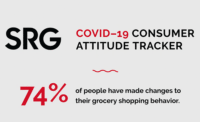The Snacking Shift
Research by the Hartman Group finds U.S. consumers snacking more, dining alone more and eating more food on the run.

“This cultural shift puts a new burden on U.S. food companies to create products that are fresh and healthy enough to eat regularly, plus tasty and interesting enough to compete with a host of restaurants, taco trucks, coffee shops and other food venues,” says Laurie Demeritt, Hartman Group CEO. “To fully understand what consumers want, it is important to study the cultural forces underpinning what and how they eat.”
In the area of snacks, busy consumer lifestyles have reduced the time available for traditional meals and precipitated a rise in snacking—to the point that snacks now represent half of all eating occasions.
The Hartman Group’s 2013 report “Modern Eating: Cultural Roots, Daily Behaviors” finds several key snacking drivers. Physical need drives 73% of snacking occasions, with 44% of them for hunger abatement, 15% for nutritional support and 12% for an energy boost to combat fatigue.
Emotional drivers factor in 36% of snacking occasions. Interestingly, 23% of these types of occasions are little more than “time markers,” as the Hartman Group terms them, to create structure in the day. Boredom alleviation factors into 13% of snacking occurrences, with 6% of snack occasions serving as simply a reward or point of encouragement.
Social and cultural pressures drive 28% of snacking in the country. Consumers are bonding around food while not committing to a full meal; and also are utilizing the snacking occasion as something of a means of experimentation. It serves as a quick, convenient and simple option to discover new cuisines and flavors.
Consumers in the U.K. and, for that matter, in the U.S. have seen the Pringles brand incorporate unique flavors into the well-known crisp. In the U.S., the flavors have been fairly reserved, with Pecan Pie and Cinnamon & Sugar serving as the boldest venture for Pringles. The U.K., however, saw a Mint Chocolate Pringles option around the holidays, following up on Roast Turkey Pringles from holiday seasons past.
Japan’s snack market may be mature but that does not at all mean the country suffers from a lack of interesting innovations. In May, Prepared Foods’ “Hitting the Shelves” print column mentioned a bake-it-at-home Kit Kat in Japan. More recently, PepsiCo has introduced Mountain Dew flavored Cheetos to the country, right on the heels of a Pepsi-flavored version several months ago.
Japan also has seen a new ice cream blur the boundaries of snacking with dessert and nutrition. It’s Häagen-Dazs’ launch of two vegetable ice cream flavors: Tomato Cherry and Carrot Orange. The latter variety features concentrated carrot juice, concentrated orange juice, orange pulp and orange peel, while the former combines tomato with cherry, and both promise roughly 8.5% milk fat, barely more than half of the company’s traditional ice cream options. Häagen-Dazs’ line also includes a “Spoon Vege” variety.
Back in the United States, researchers say snacks now comprise more than a third of the average consumer’s daily caloric intake, and more than 50% of Americans snack two to three times a day. Sadly, without a strong regard for nutritious snacks, Americans have experienced unwanted—perhaps even unexpected—weight gain.
For its part, South Beach Diet recently announced a “strategic snacking” platform, which officials describe as a “bold new idea to healthy living and dieting.” The new line helps manage weight with new protein- and fiber-rich snacks such as 100-Calorie Snack Bars, South Beach Diet Smoothies and ProteinFit bars.
Want fries with that? The quest for the healthy French fry continues and new options include a healthier side at Burger King. The fast-food giant says its new Satisfries contain 40% less fat and 30% fewer calories than the chain’s regular fry option. Meanwhile, ConAgra Foods’ Alexia brand targets at-home eating with new Smart Classics Fries and Potatoes. These promise 98% fat-free fries with 100 calories per serving. ConAgra says the fries actually are roasted and never fried. They feature Yukon Select Potatoes in three varieties: straight-cut, crinkle-cut and skillet-style, tri-cut potatoes.
What about those more health-conscious consumers wanting to nibble? For consumers seeking an organic snacking option, the options once were fairly limited. A January 2013 Organic Trade Association (OTA) survey found 81% of U.S. households purchased organic foods and OTA notes that more organic snacks have emerged to round off the broader product offerings.
One new example involves Clif Bar & Company’s Mojo Fruit & Nut and Mojo Dark Chocolate bars. They are crafted with 70% organic ingredients and also are gluten free. Like the other Mojo varieties, the two new bars contain 200 calories or less, 0g of trans fat and promise to be low glycemic and a good source of fiber.
Elsewhere, Frito-Lay extended its Stacy’s brand with new Pretzel Thins, baked snacks that combine the classic pretzel flavor with a thin, crispy texture. Made in the “Stacy’s way,” the line includes such ingredients as sea salt and organic honey, while utilizing expeller-pressed sunflower oil. It also boasts two flavor varieties: Simply Naked (incorporating sea salt to the pretzel flavor) and Honey Dijon, with Dijon mustard and organic honey.
Looking for a reprint of this article?
From high-res PDFs to custom plaques, order your copy today!







